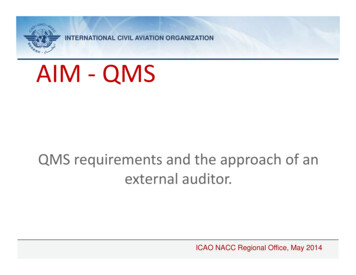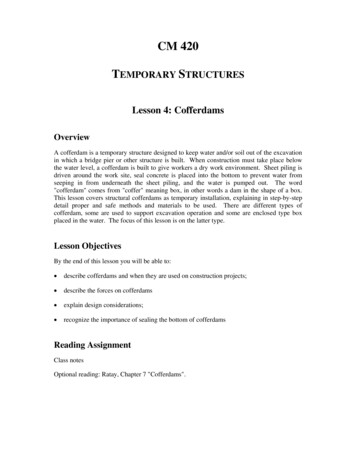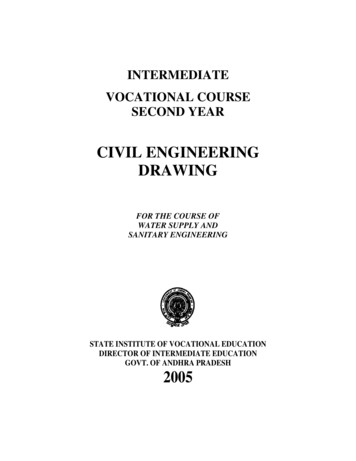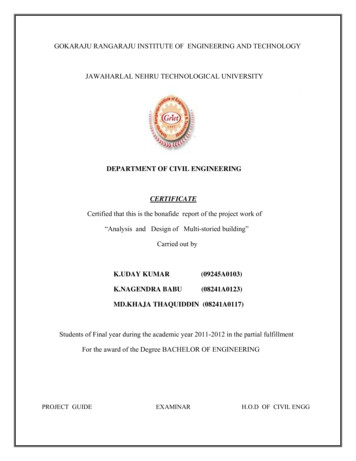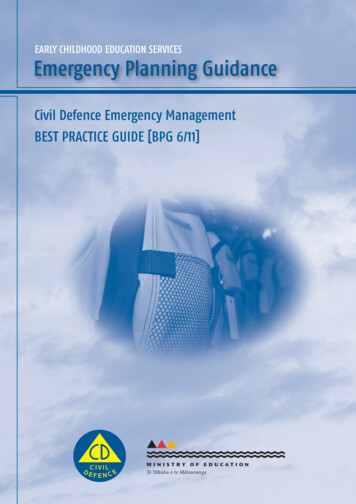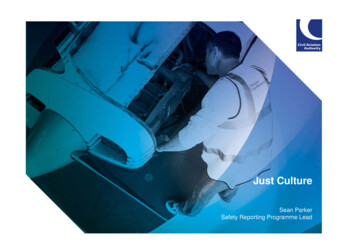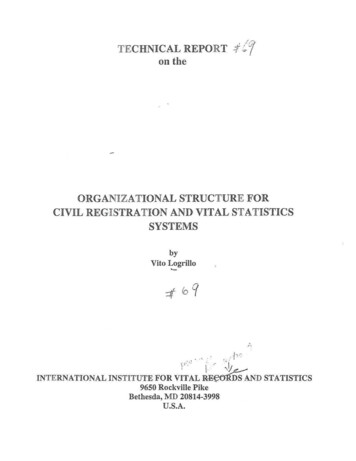
Transcription
TECHNICAL REPORT -f (/on theORGANIZATIONAL STRUCTURE FORCIVIL REGISTRATION AND VITAL STATISTICSSYSTEMSbyVito Logrillo.-::IfI(0(':(I,.'f,., ' i ' '· \!:·) INTERNATIONAL INSTITUTE FOR VITAL R-E AND STATISTICS9650 Rockville PikeBethesda, MD 20814-3998U.S.A.
FOREWORDAs countries throughout the world work to develop and/or improve their civil registration and vitalstatistics systems it is important that persons responsible for such programs consider the differentorganizational structures that have been used to achieve the goals desired. The author points out themany forms that the organizational structure has taken in different countries and the necessaryinter-agency relationships that different structures require. A key distinction in this report is madebetween the centralized and decentralized systems. What this difference in structure means for theoperations of the civil registration and vital statistics systems is carefully described.The views expressed in this report are those of the author and do not necessarily reflect those ofIIVRS.The program of the International Institute for Vital Registration and Statistics, including theby a grant from the United Nationspublication and distribution of the Technical Papers, isPopulation Fund.,.- supporfed
PREFACEThe organization of civil regjstration and vital statistics systems in various countries differ accordingto the existing legal and administrative structures in place in the country. The establishment of acentralized or decentralized civil registration program is based on the existing infrastructure of thegovernment agencies. The different modes of operation that exist require specific organizationalstructures. The civil registration and vital statistics systems developed in the different countriesrelate to these functions and activities.'This report has been prepared to provide general guidelines and descriptions of the organizationalcomponencs of civil registration and vital statistics systems under different administrative structures.Specific attention is given to organizational structures and units that are required to implement thesesystems. Situations in which single or multi pl . agencies have responsibility for civil registrationand vital statistics systems are also addressed. ·Consideration is given to the organizational components and their different structures based on thedirection taken in establishing and operating civil registration and vital statistics systems. Thedifferent aspects described in this report relate to centralized and decentralized governmentadministrative systems . A centralized system is where the responsibility of the civil registrationsystem is at the national government; the decentralized system is where responsibility for the civilregistration system is at the state or provincial level. Within each of these organizational structures,single or multiple agency responsibilities for registration and vital statistics may be designated inorder to have an effective system.A number of different organizational structures are presented in. ihis report in an attempt to coverthe most common aspects of the various administrative settings, with single or multiple agencyresponsibilities for registration and viral statistics activities.Relationships with other agencies and programs which utilize the registration data are included aspart of the organizational arrnngement for each system. These include 1) reporting sources for thedata, 2) government programs in the areas of health and social services, 3) voluntary programs whichaddress health and legal issues, 4) health research and epidemiologic investigations and, 5) vitaland health statistics information. How these agencies and programs are involved depends on theorganizational structure of the systems. Organizational structures are presented which may beimplemented to meet these needs.Sources of information directed at these topics and issues include the publications listed in theREFERENCE section of the rep?rtll
ORGANIZATIONAL STRUCTURE FORCIV][L REGISTRATION AND VITAL STATISTICS SYSTEMSSECTION I: INTRODUCTIONI. GENERAL PRlNCIPLESA civil registration system represents the identification, collec tion and recording of selected vital events including livebirths, deaths, fetal deaths. marriages and dissolutions of mar·riage (divorce) The results of the system based on the infor mation obtained from the individual reporting form of eachevent are then used to support a variety of functions and ac tivities . The extent and type of utilization of the informationmay differ among countries with registration systems as aresult of their organizational structure and operational charac teristicsDepending on the functional status of a country's system,registration data and information may be used for multiplepurposes. These may include personal needs; social, health,and administrative services; policy development, planning,and evaluation; and, statistical and research applications.Countries where registration systems have not been estab lished, the development and implementation of a systemshould consider these components as part of the planning proc ess for incorporation into the system. For existing systems,changes should be considered for meeting the broad conceptsthat civil registralion activities can provide if currently not inthe systemThe utility of the civil registration system from the pe1 sonnlviewpoint covers a broad area . This includes personal identi fication, citizenship, marital status, family structure, inheri tance and other related civil lights. The recorded vital event inthe civil registration system provides a secure source for ac cessing registration informa tion which may be required forlegal, social, economic or other personal requirements Docu mentation for the various vital events related to an individualor family represents a positive incentive for a population toregister these events. It is essential that the population is in fonned and aware of the personal benefits of the registrationsystem to obtain complete and accurate reporting.The social benefits associated with the registration system re late both to the individual and to the population as a whole .Age of a child for school entrance is established by providinga copy of the birth record . Government support programs toindividuals and families such as pension benefits, insurancecoverage, inheritance, and employment generally requi1edocumentation befo1e the services or benefits can be obtainedCivil registration records cover the essential legal informationto justify and receive such services . For the population as awhole, civil registration records can be used by governmentand private and voluntary agencies to establish progiams, pro vide services or support facilities to meet legal, social andhealth needs These activities and programs may be directed atregional or national issues identified from the various report ing data sources.Information from the birth records can be used to addressmaternal and child health issues Death records, from whichinformation based on causes of death, selected demographics,or geographic areas showing high mortality rates. can be usedto direct app1opriate resources to the population or areas af fected. Marriage information cnn be used 10 assess future fer tility patterns. family planning needs and related newborn andadolescent services . Data tegarding dissolutions of marriagecan provide information related to family and child servicesand economic support as a result of reduced income and otherfactors affecting family needs.To address social issues for the individual and for the totalpopulation, relevant information can be derived from the civilregistration system's recorded vital events. To accomplishthese objectives, organization of the civil registration systemand the vital sta istics system derived from the registrationrecords must be clearly established within the existing govern mental administrative structures This is essential for address ing population, social, economic and statistical issues. Aprogram consistent with the existing organizational frameworkof the national government is an effective approach to accomplishthe stated goals of the registration and vital statistics systems.In principle, the pdmary goal of the civil registration systemis to have complete, consistent and timely reporting and re cording of each vital event that occurs in order to provideinformation to the individual and to the administrative andprogram needs of the governmental agencies involved in thep1ocess. For the vital statistics system, the goal is to haveavailable complete, accurate, and reliable data. These data canthen be used for purposes of 1) demographic, statistical andhealth research; 2) planning. development and evaluation ofmedical and heal!.h programs; and, 3) for preparing and dis semination of timely reports based on the detailed data col lected from the recorded vital events.A necessary component to effectively meet these goals is theorganizational structure of the system From the organizationalperspective, a centralized organizational structure offers themost direct approach to meet the specified goals of each sys tem . A single national agency with responsibility for the civilregistration and vital statistics systems within a centralizedsystem can prove very effective in meeting the stated goals,and most efficient in the management and operation of thesystems . The completeness, timeliness and reliability of thereported vital events are secure when combined with a nation
to identify the key eiements and relationships that need to bein place to have an effective registration system. These in tummust be related to the legal infrastructure of the country. Givena specific administrative structure, the direction and orienta tion of the 1egistration system should be developed consistentwith that structure Io this way, the registration program canbe developed without major administrative or legal changes Making such changes can often cause significant delays anddifficulties in the implementntion phase .wide network of local and regional government registrationoffices reporting within a centralized system .Consistent with this type of organizational arrangement is thecapability to establish and maintain standards for reponing,data collection, and processing of information Modificationsand amendments to the various components of the system,whether they relate to vital records or to vital siatistics, can beaccommodated more effectively when the responsible p10 grams are located in a single agency Item definitions, recordreformats, code structures for demographic and health vari ables, and processing techniques . are more easily developedand implemented when these system components are under asingle authority .A. National Centralized SystemIn a centralized system, there are two options which may relateto the administration of a civil registration program and vitalstatistics system One is where the responsibilities for bothactivities rests within a single organization such as the Na tional Statistics Office, or in the Ministry of Health, Interior,or Home Affairs . The other is where the two functions areseparate, with civil registration under the responsibility of oneagency and the vital statistics system under another agencyGiven these different administrative structures, the registrationsystem will have varying responsibilities and fonctions .Within a centralized structure, it is necessary to maintain closeworking relationships with other agencies and programs whichutilize the data and information derived from the registrationand vital statistics systems. Inter-agency coordination, and thepossible integration of vital statistics data with other data sys tems including administrative record systems, specialized reg isters and indexes, census files , and research databases areimportant elements that must be considered. These elementsserve to optimize both the civil registration and vital statisticsprocesses Completeness of reporting and data accuracy in thecivil registration system can be monitored using other data andinformation sources This approach se1ves to improve the vari ous systems involved in the process.J, Single Agency for Civil Registration and Vital StatisticsCENTRALIZED CIVIL REGISTRATION ANDVITAL STATISTICS SYSTEMS ·- NATIONAL LEVELSINGLE AGENCY SYSTEMSOther elements such as legal requirements of the registrationsystem, privacy and confidentiality of the individual's records,and record maintenance, storage and retrieval can best be co ordinated within a single responsible agency. The comp lica tions associated with having to deal with other independentagencies to address various registration and statistical issues,system modifications, legal changes, and processing method ologies related to registration and vital statistics when the sys tems' components are distributed among several agencies canbe very time-consuming, difficult and often times nonproductiveI,MJNISTAY .,··,·· ;.::.VS OFFICE,.MunicipalityDistrictRegionThe general organizational infrastructure of government ad ministrative and program functions differ widely among coun tries throughout the world For this reason it is necessary todefine various organizational structures for civil registrationand vital statistics. An appropriate system can be implementedwhere there is consistency with the organizational and admin istrative infrastructure of the country . The general principlesfor selected registration and vital statistics functions often canbe incorporated into the system of most countries since theyrepresent the fundamental aspects of the program for any or ganizational environmentFigure lII. ORGANIZATIONAL STRUCTURESFigure 1 represents a civil registration system where the regis tration and vital statistics responsibilities are placed in a singleadminisu-ative organization. This system integrates the twofunct
organizational structure of the system From the organizational perspective, a centralized organizational structure offers the most direct approach to meet the specified goals of each sys tem. A single national agency with responsibility for the civil registration . and . vital . statistics systems within a centralized


